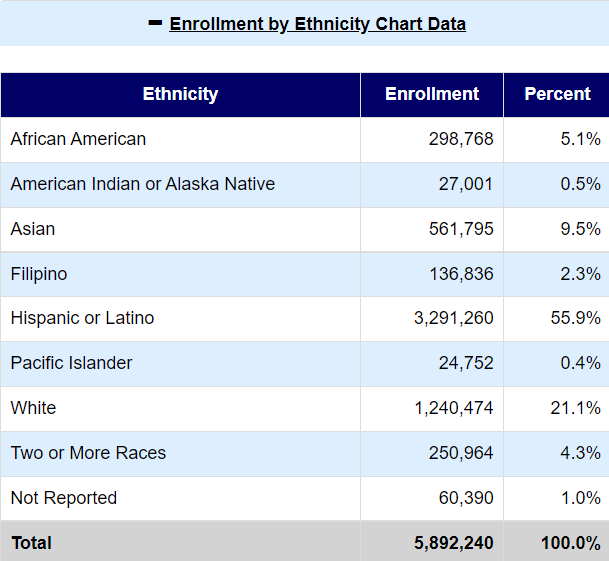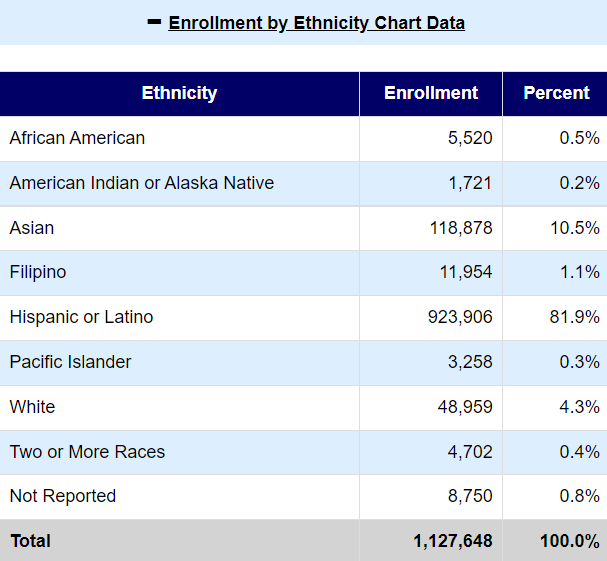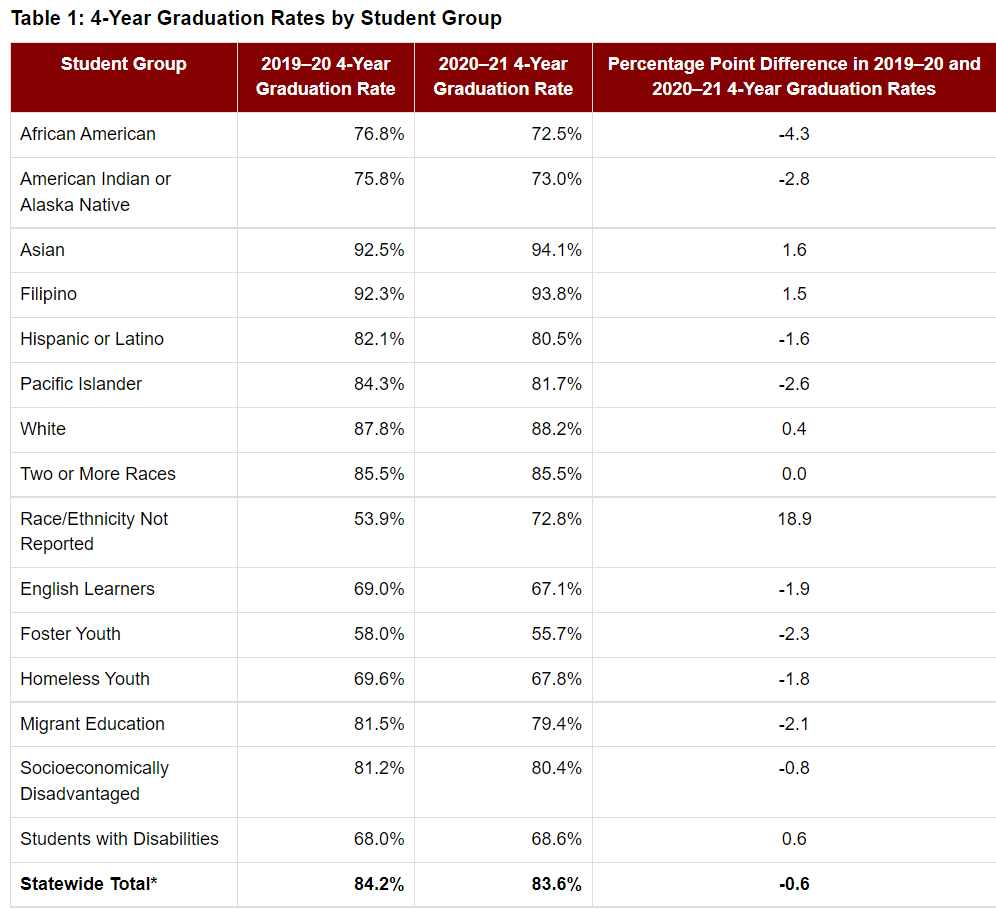PROFILE OF CALIFORNIA
THE PUBLIC EDUCATION SYSTEM OF CALIFORNIA
by Daniel Kotorri
– Student Population and Demographics
- Total public school student population: 5,892,240 students (2021-22) [1]
- Private school attendance: 489,488 students (2021-22) [2]
Student Demographics
All charts regarding student demographics are derived from [23]
- Enrollment by Race/Ethnicity:

2. Enrollment of English Learners:
- English Learners consist of 19% of the student population

3. Enrollment of Socioeconomic Disadvantaged Students:
- Socioeconomic Disadvantaged students consist of nearly 60% of the student population

– Funding and Expenditure Statistics
- National average per-pupil expenditure for public schools:
- $14,360 [3]
- California average per-pupil expenditure:
- $21,596 [4]
- Total state public education budget:
- $124.3 billion [4]
– Graduation and Dropout Rates by Demographics
This table illustrates the 4-Year Graduation Rates by Student Group in 2019-20 and 2020-21. [5]

This table illustrates the Dropout count and rate by Student Group in 2019 and 2020. [24]

– Adoption of Common Core and Next Generation Science Standards
Adoption of Common Core:
- In 2010, more than 40 states adopted the same standards for English and math. These standards are called the Common Core State Standards (CCSS). These standards illustrate the material students need to know in each grade. [6]
- In 2015, students in California take their first official round of Common Core-aligned English Language arts and math standardized tests. [7]
- Here you will find two links that show the California K-12 Common Core Standards in detail:
- English Language Arts & Literacy in History/Social Studies, Science, and Technical Subjects: [6] https://www.cde.ca.gov/be/st/ss/documents/finalelaccssstandards.pdf
- Mathematics: [6] https://www.cde.ca.gov/be/st/ss/documents/ccssmathstandardaug2013.pdf
Adoption of Next Generation Science Standards:
- In 2013, the State Board of Education (SBE) adopted the K-12 Next Generation Science Standards for California Public Schools. [8]
- Here you will find a link that shows the Three Dimensions of the CA NGSS: Science and Engineering Practises, Disciplinary Core Ideas, and Crosscutting Concepts [8] https://www.cde.ca.gov/pd/ca/sc/documents/ngssataglance.pdf

[25]
– Accountability Measures (testing, portfolios, growth, etc.) and the Subject Matter Accessed
- CA School Dashboard & System of Support
- Current year results
- Potential improvement from the previous year
“State measures include chronic absenteeism, graduation rate, suspension rate, and academic (which includes performance in English language arts/literacy and mathematics).” [9]
The bar below illustrates how the performance of districts, schools, and student groups is measured: [9]

[22]
- School Accountability Report Card (SARC)
Every year, California public schools provide information to the community allowing the comparison of schools “for student achievement, environment, resources & demographics.” [10]
- High School Equivalency (HSE) Tests
In order to receive a California High School Equivalency Certificate, the state has approved two high school tests (GED® and HiSET®) for students 18 years old and older. [11]
Here you will find more information regarding the 2021-22 California Assessment (grades, testing, participants): California Assessment of Student Performance and Progress (CAASPP), English Language Proficiency Assessments for California (ELPAC), and Physical Fitness Test (PFT)
http://www.cde.ca.gov/ta/tg/ai/documents/calassesssystem.pdf
-Calculating Growth Scores
“California’s student-level growth model methodology uses statewide Smarter Balanced test results from students in grades four through eight.” [12]
“First, we need to determine the student’s expected test score. The expected test score is determined by looking at students who had similar test scores in the previous grade and then evaluating their typical test scores in the current year. “Once an expected test score is determined for each student, the difference between the student’s expected test score and their actual test score is compared to arrive at their individual growth score.” [12]
– Testing or proficiency graduation requirements
Students must fulfill state and district graduation requirements in order to receive a high school diploma. There are 13 courses of preparation. The state-mandated minimum graduation course requirements are: [13]
- “Three years of English
- Two years of mathematics (including Algebra I)
- Three years of social science (including U.S. history and geography; world history, culture, and geography; one semester of American government; and one semester of economics)
- Two years of science (including biology and physical science)
- Two years of physical education
- One year of foreign language or visual and performing arts or commencing with the 2012–13 school year, career technical education. For purpose of satisfying the minimum course requirement, a course in American Sign Language shall be deemed a course in foreign language” [13]
Local school boards and different districts often have more graduation requirements than the state-mandated requirements. [13]
– Number of charter schools and percentage of students served
- In the 2021–22 school year, more than 1,300 charter schools, out of which there are seven all-charter districts, operate in the state of California. [14]
- In the 2020–21 school year, 11.5% of the public school student population in California were enrolled in charter schools. [14]
– Voucher dollar amounts and percentage of students served:
- California does not currently offer vouchers or tuition tax credits for private school choice. [15]
– Permissible voucher use (i.e., religious schools):
- The state of California does not provide vouchers to parents, so voucher use is not permissible for any independent schools, religious or secular. [15]
– Average teacher salary:
- The average teacher salary in the state of California was $84,531 in 2019/20. This figure is far higher than the average national teacher salary in 2020, which was $63,645. [16][17]
– Presence of teachers unions/collective bargaining (e.g., AFT/NEA):
- The California Teachers Association (CTA), a local affiliate of the National Educators’ Association (NEA), is the main teachers’ union in California. CTA has leads for more than 150 years, fighting for educators’ and students rights to quality education. [18]
- CTA mainly advocates for issues regarding immigration reform, alternative discipline methods, school safety (among students, teachers, and administration members), retirement security, class size, community schools, and state budget (fair allocation of funding). [18]
- CTA consists of a wide variety of members, with more than 310,000 educators across the state of California. It includes teachers, counselors, psychologists, librarians, Education Support Professionals, school nurses, higher education faculty and staff, students preparing to join the profession and retired educators. [18]
– Merit Pay System
- California has over 100 merit system school districts. “A merit system may be voted into a district by local board of education action, by a majority vote of the district’s classified employees, or by a majority vote of the voting electors of the school district.” [19]
- “The Personnel Commission is the mainstay of the merit system. It is an independent body composed of three persons appointed for three-year staggered terms. Commissioners are lay persons who must be known adherents of the merit principle. The personnel commission is responsible for maintaining a merit system for classified employees of the school system and for fostering the advancement of a career service for such employees.” [19]
- Here are the primary principles of the merit system:
- “Selection and promotion based on merit and fitness, as determined by competitive examinations.
- Retention on the basis of demonstrated performance.
- Classification of positions on the basis of the duties and responsibilities actually performed.
- Compensation pursuant to the like pay for like work principle.
- Appeals from administrative action before a neutral third party.” [19]
– Teacher evaluation methods and measures
- California has no state-mandated teacher evaluation program. Each district develops its own system and schools are obligated to evaluate teachers under the Stull Act. [20]
- Given the current law, Stull Act, teachers can negotiate evaluation procedures, “such as the timing and frequency of classroom observations.” However, they cannot negotiate and decide the criteria for evaluations. For example, teachers cannot decide whether to use student surveys of teacher performance and what tests to use to measure student academic progress. [21]
- The Stull Act requires teachers to be evaluated on “instructional techniques, classroom management, implementation of the curriculum and student growth, but leaves the specifics of how to judge performance to districts.” [21]
- For example, the figure below illustrates the teacher supervision and evaluation process the Fresno Unified School District uses: [22]

You can find more information about the policies the Fresno Unified School District has adopted below: https://www.nctq.org/dmsView/Teacher-Evaluation-Handbook
Data Analysis
One of the most apparent inequalities in the public schools of California is the disparity in the graduation and dropout rates among various ethnicities. Based on the 2020-21 graduation rates, African American students graduate within 4 years at a 72.5% rate and Hispanic students at a 80.5%, compared to White students who graduate at a 88.2% rate. [5] Based on the 2020 dropout rates, African American students have a 13% dropout rate and Hispanic students have a 9.8% dropout rate, compared to White students who have a 7% dropout rate. [24]
Many factors contribute to these inequalities, with funding allocation and segregation being very important ones. Public schools across the country are primarily funded by property taxes. As a result, districts with the most financial support from their community receive the best funded education and most likely the best quality education in general. Students who live in poor districts are doomed to attend schools that receive less funding and therefore, do not have the same quality education. The problematic allocation of funding creates unequal learning environments for students in different areas of the state, which lead to unequal opportunities later in life.
These inequalities are preserved due to the systemic racial segregation that exists in California. Southern California schools show intense segregation in education as “more than two out of five Latino and nearly one-third of all black students” are enrolled in that region. [26] 26.2% of households surrounding predominantly White high schools earned greater than twice the state median of $62,500 annually, compared to 15.6% of households surrounding segregated schools. [26] This statistic shows that students in wealthier districts have a comparative advantage over students who live in poorer districts because the funding in wealthier districts in much greater.
Current Events
Charter Schools Drain Money from Public Schools
Journalist Erica Green wrote about charter schools that applied for loans through the federal Paycheck Protection Program in California. “The report finds that nearly $19 million has been awarded to charter schools in the Oakland Unified School District, with 70 percent of the district’s 43 charter schools accepting the funding.” Additionally, Bullis Charter School in Los Altos was granted $2 million in forgivable loans through a federal relief program. This fund was supposed to help small businesses that struggle during the COVID-19 pandemic. [27]
California is the state with the most charter schools across the nation. About 10% of California’s student population is enrolled in charter schools. The per-pupil funding from these students is being diverted away from public schools, which leaves less resources for public schools leading to lower quality education. For example, “the Los Angeles Unified School District lost 600 million dollars annually because of charter schools.” Those 600 million dollars could be allocated to public schools that are in actual need, especially with the ongoing pandemic. [28]
Tying it back to the bigger picture, the existing racial segregation that exist in the state of California along with the growth of charter schools negatively affect the public education system. The unfair allocation of funds create an unequal learning environment that puts students from poor districts in disadvantage, especially students of color. [28]
Here is a video on how charter schools drain funding from public schools.
[29]
WORK CITED
https://docs.google.com/document/d/1rqkYVtvIWyg_Q3rY_wscsCONYgjcOT9pcOaeQNHPl0U/edit?usp=sharing
